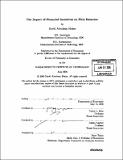The impact of financial incentives on firm behavior
Author(s)
Matsa, David
DownloadFull printable version (8.925Mb)
Other Contributors
Massachusetts Institute of Technology. Dept. of Economics.
Advisor
Nancy L. Rose and Joshua Angrist.
Terms of use
Metadata
Show full item recordAbstract
This dissertation analyzes the impact of various financial incentives on firm behavior. The first two chapters examine product-market and input-market effects of a firm's capital structure and the incentives they create. The third chapter analyzes how incentives from the tort system affect physician location decisions. Chapter 1 examines the impact of union bargaining on capital structure determination. If a firm maintains a high level of liquidity, workers may be encouraged to raise wage demands. In the presence of external finance constraints, a firm has an incentive to use the cash flow demands of debt service payments to improve its bargaining position. Using both cross-sectional estimates of firm-level collective bargaining coverage and state changes in labor law to identify changes in union bargaining power, I show that firms indeed appear to use financial leverage strategically to influence collective bargaining negotiations. These estimates suggest that strategic incentives from union bargaining have a substantial impact on financing decisions. A firm's financial structure can also impact investments in marketing and operations management. Chapter 2 examines how capital structure affects a firm's provision of product availability - an important dimension of product quality in the retail sector. (cont.) Using U.S. consumer price index microdata to measure the prevalence of out-of-stocks, I find that supermarket leveraged buyouts, which reduce liquidity, increase out-of-stocks by 10 percent. These findings suggest it is important for firms to consider these sorts of real effects on their operations when setting financial policy. Chapter 3 examines financial incentives created by medical malpractice liability. If patients bear the full incidence of cost changes and market demand is inelastic, then marginal changes in malpractice liability will not affect physicians' net income or location decisions. Using county-level, specialty-specific data on physician location from 1970 to 2000, I find that damage caps do not affect physician supply for the average resident of states adopting reforms. On the other hand, caps appear to increase the supply of specialist physicians in the most rural areas by 10 to 12 percent. This is likely because rural doctors face greater uninsured litigation costs and a more elastic demand for medical services.
Description
Thesis (Ph. D.)--Massachusetts Institute of Technology, Dept. of Economics, 2006. Includes bibliographical references.
Date issued
2006Department
Massachusetts Institute of Technology. Department of EconomicsPublisher
Massachusetts Institute of Technology
Keywords
Economics.